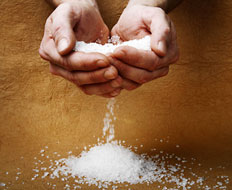With the release of an Institute of Medicine (IOM) report recommending the government regulate the amount of sodium in the nation’s food supply, the restaurant industry says it wants to take action—on its own.
“The industry supports a voluntary, incremental approach to reducing sodium levels in menu items, and would have concerns about any potential government mandate that creates a one-size-fits-all rule to ingredient standards,” the National Restaurant Association said in an April 20 statement, released the same day as the IOM report.
Across the industry, operators have bridled at possible sodium regulation, especially since it would force them to lower the amount of salt on their menus. Salt is the primary source of sodium and, many contend, flavor in foods.
“There is no need to have a government mandate,” says Paul Mangiamele, CEO of Salsarita’s Fresh Cantina. “What’s next, the government mandates what a customer can eat?”
On the heels of a health care overhaul that would fine some employers who do not cover their workers, the prospect of government oversight of sodium levels has further riled John Brodersen, a Popeyes franchisee with 11 Detroit locations.
“These new mandates [are causing] restaurant operators and business owners to stop building new businesses until the crossfire ceases and we can begin to sort all this government intrusion out,” Brodersen says. “The net effect, I fear, is that no jobs will be created by us, and the U.S. economy will sit on the sidelines watching all the growth going on overseas.”
In 2008, Congress asked the IOM to recommend strategies for lowering the amount of sodium Americans consume to the levels prescribed in the nation’s dietary guidelines, no more than 2,300 mg per day (about a teaspoon). The average American consumes about 3,400 mg per day, or 50 percent more than the recommended amount, according to the report. Such high sodium consumption increases the risk of high blood pressure and can lead to cardiovascular disease and other disorders.
The IOM report calls for a gradual lowering of sodium “in a way that should avoid making food unpalatable to consumers.” The report does not propose a specific step-by-step schedule for the reduction.
The IOM recommended a mandate, says one of the report’s contributors, because voluntary efforts by the foodservice industry over several decades have not lowered the average American’s sodium intake to a safe level.
“There’s been efforts for almost 40 years here in the U.S. to reduce the level of sodium through various voluntary efforts, whether it be education of consumers or encouraging manufacturers, food processors, and restaurants,” says John Ruff, former head of R&D for Kraft. “But they have not achieved the end goal.”
Ruff says voluntary reductions don’t work in part because companies are reluctant to lower the sodium in their products if their competitors don’t as well.
“That’s why it’s critical to have everyone on board,” Ruff says. “It’s important to level the playing field.”
There is one recent sign, however, that the foodservice industry might have the will to tackle sodium reduction without the government forcing the issue. Sixteen companies, including Starbucks and Subway, pledged on April 26 to voluntarily cut down the amount of sodium in their products as part of the National Salt Reduction Initiative (NSRI). A public-private partnership New York City launched in January, the NSRI seeks to cut salt consumption by 25 percent over five years.
Subway dietician Lanette Kovachi says the chain is working on a line of low-sodium offerings that it will roll out over the next four to five years. Finding the right balance of flavor, she says, has not been easy.
“It definitely is challenging,” Kovachi says. “There’s a lot of work that goes into finding the right level of sodium in a given product while maintaining the flavor.”
But Kovachi says choosing to go the low-sodium route will help Subway stay ahead of the pack on an issue that is gathering steam.
“Sodium is such a hot topic and a lot of other members of the food and restaurant industries are looking at ways to get it down,” she says. “They just might not have come out and publicly committed to doing so.”
The NSRI notwithstanding, some public-health advocates aren’t impressed with the restaurants’ commitment to lowering sodium.
“The restaurant industry might not like being told that it has to lower sodium, but where has it been for 40 years?” says Michael Jacobson, executive director of the Center for Science in the Public Interest.
Whether the government will act on the IOM’s recommendations remains to be seen. The FDA released a statement the day the report came out that said it “is not currently working on regulations nor has it made a decision to regulate sodium content in foods at this time.”
Ruff says the government “will go down a regulation path,” mandating 10–15 percent sodium reductions in roughly three-year steps.
“We’re not proposing to do this overnight,” Ruff says. “People have tried to do this faster and failed. We think it’s more appropriate to go about this deliberately.”













